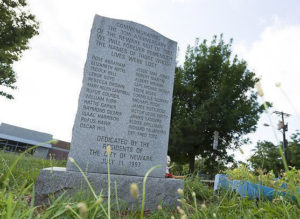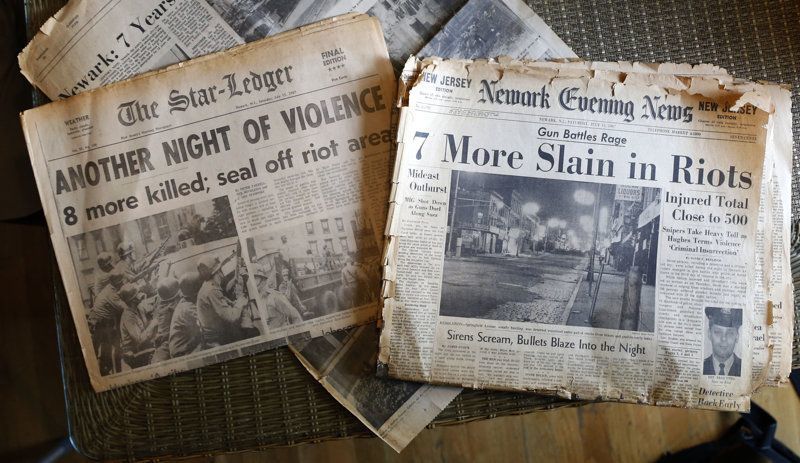How urban riots 50 years ago changed politics and our country forever
Few events in the last 50 years were as pivotal in terms of how and where we live, work, and whom we associate with than the riots that rocked American cities in the 1960s. What I call “Revolution Summer, 1967” was noteworthy above all other “long hot summers.” Some 160 cities erupted, and as July 1967 closed, after days of rioting, 47 lay dead in Detroit, 26 in Newark and one (a police officer) in Plainfield, NJ. Most of these victims were black.

1997 memorial to the victims of the Newark riots 40 years earlier (Photo Credit: NYT)
I grew up in New Jersey during this era, worked at The Star-Ledger newspaper in Newark as a proofreader, stringer and reporter (1978-1983), and covered Newark and Plainfield. In addition, I have served Leesburg (an urbanized town) for 10 years as a local elected councilmember and county supervisor.
I have studied the 1960s riots extensively and have lived in numerous cities with large minority populations, too. No, I am not an “expert,” just an observer, and here are a few examples of how the race riots reshaped our country and politics:
- In 1967, Detroit was America’s 5th most populous city with about 1.3 million residents. Largely due to “white flight” and deindustrialization, Detroit today only has 713,000 residents and has so many abandoned and collapsed buildings, you’d think it had been hit by aerial bombing. It was in bankruptcy some years ago. It is only 10% non-Hispanic white. A Detroit TV station reported recently that immediately after the riots White flight was frantic. “Sixty-seven-thousand people fled in the summer following the uprising, 80,000 more the following year.” Those numbers are staggering
- Newark’s numbers were comparable. Newark had about 400,000 residents at the time of the ‘67 riots, and had a white population of about 50%, which was dwindling. Today, Newark has about 280,579 residents, which actually represents an increase from the 2000 census, and is about 26% non-Hispanic white. In the 1970s and 80s, the city was giving homes away for nearly nothing.
- African-Americans gained political power in the cities, but with whites departing, so did business (notably, retailers), jobs and a tax base. This left major urban areas in a fiscal crisis in the 1970s with heavy dependence on federal and state aid and government-initiated programs to revive the cities, much of which was not very successful in my view.
- Whites who left cities became resentful about “losing” their old communities, especially blue collar whites. They started voting increasingly Republican, or for conservative Democrats like George Wallace. These folks became the “Reagan Democrats” of the 1980s. Deindustrialization led to millions of Americans moving to The Sun Belt, too.
- While the number of black office holders jumped and grew in influence in the Democratic Party, culminating in the historic election of Barack Obama in 2008, their ability to get realistic economic growth for their communities dwindled, as Republicans moved to the far right and Democrats to the far left. The consensus was not there. Key African-American groups also started to be led by more aggressive and polarizing leaders (i.e. Ben Chavis at the NAACP and Louis Farrakhan, Nation of Islam).
- The loss of jobs and middle class residents created a bigger “black underclass” in the cities and with that an increased drug trade and gang violence. Despite welfare reform in the 1990s, young women who come from broken homes and are led by a single mother have a good chance of getting pregnant out of wedlock and becoming a ward of the state. If you’re male in the same situation, you may join a gang or get involved in the illicit drug trade and wind up a victim of a shooting.
- “Black flight” became the norm in the 1990s and cities started to eye gentrification, concert halls, new convention centers and minor league baseball stadiums as a means to bring life back to their urban core. These efforts did not really help the black underclass that much.
- Both parties ignored the cities in the 1980s and looked more to policies favoring suburban voters – -i.e., the “Soccer moms” that propelled Bill Clinton into the White House twice.
- By the late 1980s, most of the nation’s population lived in suburbs, not cities. Despite the rhetoric about race relations emanating from the former Obama administration, compared to the 1960s and 1970s, most middle-to-upper class suburbanites live in harmony regardless of race, religion, ethnicity, or even sexual orientation. What divides the nation today is politics.
- Major cities with strong service-oriented economies and which avoided major riots are doing fine, New York being a leading example.
What is the lesson here? First, the loss of a commercial tax base in these cities could not be replaced by government largesse alone. Having political power is no substitute for economic power and advancement.
Today, Newark is rebounding – not because of government, but because Millennials and developers are discovering bargains on real estate compared with New York and Hudson County, NJ. Newark is in a good position due to its close proximity to New York, which is unaffordable to young people. DC is seeing a housing boom.
Second, it’s hard not to understand why African Americans rioted in so many cities in the late 1960s. They were angry and resentful of the white establishment in their communities, notably the police, which had few black officers. Blacks were migrating from the Jim Crow South and their expectations in the urban centers were not being met.
The people who agitated, looted and burned did so to their detriment as did those who rioted in Ferguson, MO, and Baltimore in recent years. The “Black Lives Matter” movement has fizzled and has garnered only sympathy from the media, academia, Hollywood and radical activists.
Violence only begets more violence. It’s arduous to “work through the system” but Martin Luther King Jr. did it successfully. He aptly noted: “The ultimate weakness of violence is that it is a descending spiral, begetting the very thing it seeks to destroy. Instead of diminishing evil, it multiplies it.”
That is the No. 1 Lesson to learn from “Revolution Summer, 1967.”
Links to learn more about the 60s riots
DETROIT –
NBC News series on Detroit after the riots
Footage of the 1967 Detroit riots and interviews with Gov. Romney others
NEWARK – Examination of Newark’s efforts to rebound after the riots
Four part series on why the Newark riots occurred — and their aftermath

